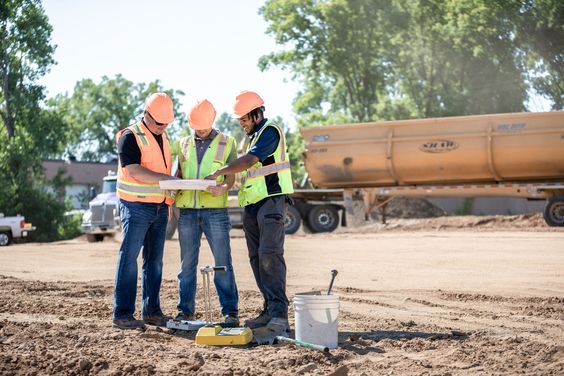Embarking on a land development project requires a comprehensive feature and level survey in Melbourne. This survey is crucial for gathering detailed data about the site, including its physical features, adjoining properties, and street elements.
At Greater Melbourne Surveyors, we understand the importance of meticulous planning and preparation before executing a survey. This blog will cover the main factors that a surveyor should consider when organizing a feature and level survey.
Survey’s Objectives-
- Site Control and Coordination
- Establish reference points to ensure all measurements are accurate and consistent.
- Align with local data, such as the Map Grid of Australia (MGA), to integrate with broader geographical systems and ensure data compatibility.
- Ensure compatibility with other mapping and planning resources.
- Design and Construction Data
- Provide detailed information about the land’s topography, existing structures, and potential challenges.
- Inform architects and builders, enabling efficient planning and avoiding costly mistakes.
- Influence design, construction, and overall development decisions, providing a reliable foundation for all stakeholders.
- Regulatory Compliance
- Ensure the survey meets local council regulations, including Res-code requirements, height restrictions, and setback rules.
- Support smoother project approvals by adhering to zoning laws and guidelines.
Let’s understand the things a surveyor should keep in mind before planning a survey-
Familiarize yourself with Local Regulations.
In Melbourne, land development projects must comply with specific local regulations:
Res-code Requirements
- Cover various aspects of residential development, including building height, site coverage, setbacks, and overshadowing.
- Ensure surveys account for these requirements to support compliance and prevent project delays or rejections.
Height Restrictions and Setback Rules
- Ensure new developments harmonize with existing buildings and the surrounding environment.
- Measure and document the heights of existing structures and proposed buildings.
- Accurately mark property boundaries and ensure proposed developments comply with setback rules.
Start by conducting a Preliminary Site Visit.
A preliminary site visit is crucial for gathering initial observations and identifying potential challenges:
Terrain and Vegetation Assessment
- Note significant changes in elevation, slopes, and other topographical features.
- Assess dense foliage or vegetation that might obstruct measurements, planning how to navigate these obstacles.
Existing Structures and Obstacles
- Document existing structures such as buildings, fences, and driveways.
- Identify any barriers like utility poles, trees, or bodies of water that might interfere with the survey.
Equipment and Technology
Modern surveying is heavily dependent on sophisticated tools and technology. To improve the precision and effectiveness of the survey, surveyors should make sure they have access to the newest equipment.
GPS Devices and Total Stations
- Establish accurate geographical coordinates for the site using GPS devices.
- Use total stations for detailed measurements of distances and angles between points.
Drones and Aerial Surveys
- Utilize drones for capturing aerial perspectives and detailed images over large areas.
- Employ high-resolution cameras and GPS technology for quick and accurate data collection, especially useful for large or complex sites.
Surveying Software
- Process and analyze collected data using specialized software.
- Create detailed maps, 3D models, and visualizations to help stakeholders understand the site’s features and plan their activities.
Coordinate with Relevant Stakeholders
Effective communication and coordination with all relevant stakeholders are vital before starting the survey:
Client Consultation
- Understand the client’s goals and specific requirements for the project.
- Set clear expectations and tailor the survey to meet the client’s needs.
Collaboration with Architects and Builders
- Ensure the survey captures all necessary information for design and construction.
- Provide specific measurements, locations of existing structures, and details about the terrain to support their planning activities.
Safety Considerations
Safety is a paramount concern during any surveying project. Surveyors must evaluate potential hazards on the site and plan appropriate measures:
Site-Specific Hazards
- Identify and address unique site hazards such as steep slopes, loose soil, or dense vegetation.
- Plan safety measures during the preliminary site visit to mitigate risks.
Personal Protective Equipment (PPE)
- Wear appropriate PPE, including hard hats, high-visibility vests, and safety boots.
- Use additional equipment like gloves, eye protection, or harnesses depending on site conditions.
Data Accuracy and Precision
Accuracy and precision are the cornerstones of a reliable feature and level survey. Surveyors should implement stringent quality control measures to verify data accuracy:
Quality Control Measures
- Regularly calibrate equipment to maintain accuracy.
- Cross-check measurements using different methods to confirm precision.
- Use redundant data collection methods to identify and correct discrepancies.
Data Verification
- Compare collected data with known reference points or previous surveys.
- Ensure data consistency and reliability, providing a solid foundation for the development project.
Environmental Considerations
Consider environmental factors to plan sustainable development practices:
Soil Conditions
- Assess soil type, load-bearing capacity, and potential issues like erosion or contamination.
- Provide crucial information for planning foundations and other structural elements.
Drainage Patterns
- Map natural drainage patterns and identify areas where water might collect.
- Create efficient drainage systems to avoid standing water and possible flooding.
Vegetation and Natural Features
- Document significant trees, shrubs, and other vegetation.
- Identify natural features like rock formations or water bodies to plan sustainable development practices.
Legal and Ethical Considerations
Upholding legal and ethical requirements is crucial to preserving the integrity of the surveying industry.
Licensing and Certification
- Ensure all necessary licenses and certifications are up to date.
- Regularly update credentials and stay informed about regulatory changes.
Property Boundaries and Permissions
- Accurately mark property lines and respect property boundaries.
- Obtain necessary permissions from property owners before accessing private land.
Documentation and Reporting
Thorough documentation and transparent reporting are crucial components of a successful survey:-
Detailed Maps and Diagrams
- Create visual aids including all relevant information, such as topographical features, existing structures, and property boundaries.
Comprehensive Reports
- Provide thorough analysis of collected data, highlighting potential issues.
- Facilitate better communication with clients and stakeholders to support informed decision-making.
Time Management
Efficient time management is essential for meeting project deadlines and ensuring a smooth workflow:
Planning and Scheduling
- Develop a detailed plan and schedule for the survey.
- Consider potential obstacles and plan contingencies to avoid delays.
Monitoring Progress
- Regularly monitor the survey’s progress to identify and address issues early.
- Keep stakeholders informed about progress to maintain transparency and ensure alignment.
Continuous Learning and Adaptation
Keep up with developments and trends in the industry to expand your knowledge and abilities.
Professional Development
- Attend workshops, courses, and conferences.
- Join professional organizations to stay current with the latest advancements.
Adapting to Changes
- Incorporate new technologies and methods into surveying practices.
- Keep up with any changes to industry standards and rules to ensure that your work is still relevant and compliant.
Client Communication
Understanding clients’ expectations and guaranteeing their pleasure depend on having effective contact with them.
Regular Updates
- Provide progress reports and address the concerns promptly.
- Maintain regular contact to build trust and ensure alignment with client expectations.
Addressing Concerns
- Be responsive and transparent in explaining findings and their impact on the project.
- Foster a positive working relationship by addressing concerns and questions.
Conclusion
To guarantee accurate and trustworthy results, feature and level survey planning requires careful consideration of many criteria. From understanding the survey’s purpose and familiarizing oneself with local regulations to conducting preliminary site visits and ensuring data accuracy, every stage is essential to the project’s success.
At Greater Melbourne Surveyors, we prioritize meticulous planning and preparation to deliver high-quality surveys that support your land development projects. By keeping these critical considerations in mind, surveyors can contribute to the smooth and flawless completion of development projects, ultimately leading to successful and sustainable outcomes.
When considering the things a surveyor should keep in mind before planning a survey, our expertise ensures meticulous planning and preparation to deliver accurate results that meet your project’s needs.


